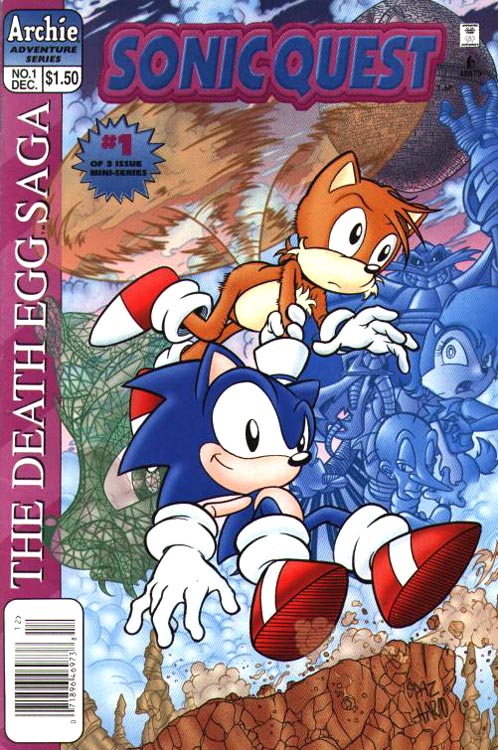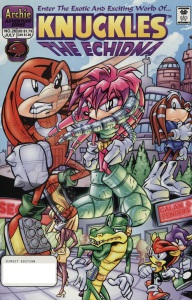
Long before Sonic the Hedgehog was their mascot, SEGA was known the world over for their fantastic arcade outings. Space Harrier. Hang On. Out Run. Each game compelled whatever young mind was near to slide quarter after quarter into the cabinet, keeping the company relevant even while their home content, featured on the Sega Master System, was overtly eclipsed by the competition. Finally finding success in the console market in 1991 didn’t slow the videogame maker from producing titles for the arcade circuit, but it did raise the question of whether or not SEGA would deliver Sonic outside of the Mega Drive, making those crazy about The Most Famous Hedgehog In The World to venture outside the home and hunch over a static arcade cabinet.
Wanting to exploit the character that was to define them, SEGA was immediately aware of the demand. In 1991, they released a pair of early games exclusive to arcades, Waku Waku Sonic Patrol Car and its spiritual successor, SegaSonic Cosmo Fighter Galaxy Patrol, two early attempts that were geared directly at a younger demographic. The first two 16-bit titles would also be retooled for arcade consumption, released on the Mega Play platform where players were given the same levels as the home version but with far shorter time limits.
It wasn’t until 1993 that the first dedicated arcade experience featuring the hedgehog was released, the aptly titled SegaSonic the Hedgehog. One look at the title screen made it clear it wasn’t just a rehash of home content, featuring two brand new characters joining Sonic in an isometric world where players had to use a trackball to get Sonic and his friends out of the never-ending trouble following them. Released at the height of Sonic’s popularity, the game was virtually ignored, in part because it was almost exclusively a Japanese title. Those few that were exported to the west came with Japanese vocals and text intact, and as such was overlooked by the writers of both Sonic comic books being published at the time.
In 1999, that all changed.
how archie played the games
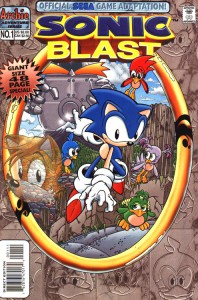 Blue is Back!
Blue is Back!
Or at least, that’s how Sega of America wanted you to think back in 1996. Five years after the release of the original Sonic the Hedgehog, the western branches of the company were scrambling to celebrate Sonic’s first semi-prominent anniversary. The original plan was to release Sonic X-treme, the first true 3D game featuring everyone’s favorite hedgehog. The story behind that title’s cancellation has become the stuff of legend, not just infamous in this here part of the world but in the general gaming community. Without that title, Sega decided to heavily promote Sonic’s swan song on the Mega Drive – Sonic 3D: Flickies’ Island, also known as Sonic 3D Blast in the United States. With a port of the game hastily developed for the Sega Saturn, along with a similarly titled Game Gear game that was otherwise unrelated, the marketing blitz began.
It was only natural for Archie Comics to craft a comic adaptation of the newest game in the franchise. Not since issue thirteen’s “This Island Hedgehog” had Archie released a comic at around the same time as the source material it was promoting, SEGA’s huge push filtering into the otherwise left alone plotlines of Archie. Did this unique timing help the 48-page special become a masterpiece? Well, that would be giving it away, wouldn’t it? Either way, let’s strap ourselves in and experience the very last of Archie’s stand-alone specials. Ladies and Gentlemen of the Jury, I present to you our seventh piece of evidence…Sonic Blast.
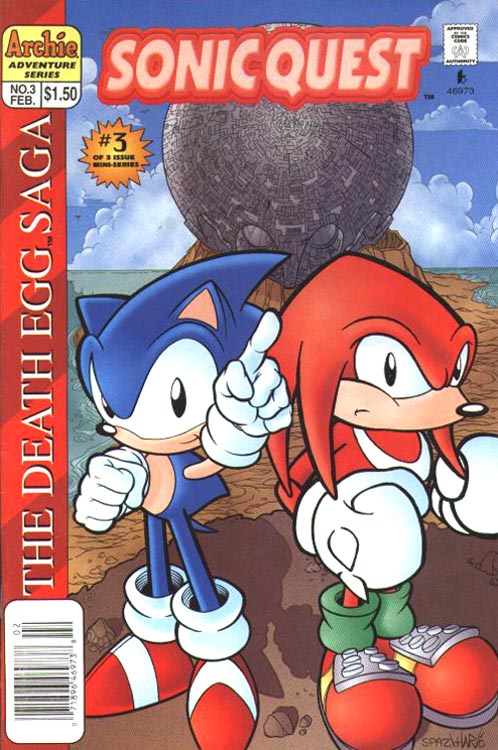
You know, it’s almost hard to believe that it’s been fifteen years since SonicQuest: The Death Egg Saga was originally published. Coming out right at the tail end of the Golden Age of the Archie series, it promised to give the readers everything they were asking for, a fun little detour as the main series began to amp itself up for “Endgame,” the four part storyline that also is seeing its fifteenth anniversary this year. Causing far more controversy than the writers were intending, Endgame was designed to be the final chapter of the comic book if it was to see cancellation in the wake of the Saturday morning series ending, and although the series instead continued to be published (and still thrives to this day), it was certainly the end of an era. SonicQuest, though it has its faults, still exists in that pre-Endgame state of mind, surely assisted by the writing style of Mike Gallagher. In fact, there is only one more game adaptation before “Endgame” would change everything…but I’m getting ahead of myself.
Picking up where we left off yesterday, we continue with SonicQuest: The Death Egg Saga, the pseudo-adaptation of Sonic 2, 3 & Knuckles, even though we already had adaptations of the latter two. So let’s find out what the heck’ll happen next.
Even though it’s easy to forget, the classic games in the Sonic the Hedgehog series did indeed have a storyline. Of the core five titles from the early 90’s, one single invention from the mind of Dr. Eggman dictated the actions Sonic, “Tails” and Knuckles would be a part of over the course of twenty five levels. I am talking, of course, of the Death Egg. Though clearly a Star Wars reference in both style and name, the giant space station (even if it was only in space for roughly ten minutes) was the centerpiece of the action that went on in Sonic the Hedgehog 2, Sonic the Hedgehog 3, and Sonic & Knuckles. So great was its importance that the station would return in numerous spin-off titles, such as Sonic the Fighters, Sonic Drift 2, and Sonic Battle. Heck, it was even meant to be in Sonic X-treme at one point, although we all know what happened there.
So it was head-scratching to think that Archie‘s previous adaptations of Sonic 3 and Sonic & Knuckles completely neglected the use of the Death Egg. Even if the writers hadn’t been able to finish the game themselves, it was mentioned more than once in the instruction manuals for all three games it appeared in. So what did we get instead? Some random ship that wasn’t much bigger than Dr. Robotnik, and a half-baked scheme that turned the bottom of the Floating Island into a death trap. Not exactly the stuff of legends. Even the Fleetway adaptations of those games used the Death Egg, so for us American fans, all we could do was write in and complain to the Archie staff that they had completely forgotten to use one of the most awesome things in the game.
Finally, Archie succumbed to the pressure, and decided to use it, adapting portions of Sonic 2, 3 and Knuckles and introducing the Death Egg into the pages of the comic. And when they did, they did it in a big way. It wasn’t just a random issue of the main series. It wasn’t even a 48-page special that had to share print time with back-up stories about Knuckles the Echidna. It was given the royal treatment. Ladies and gentlemen, I give you SonicQuest: The Death Egg Saga.
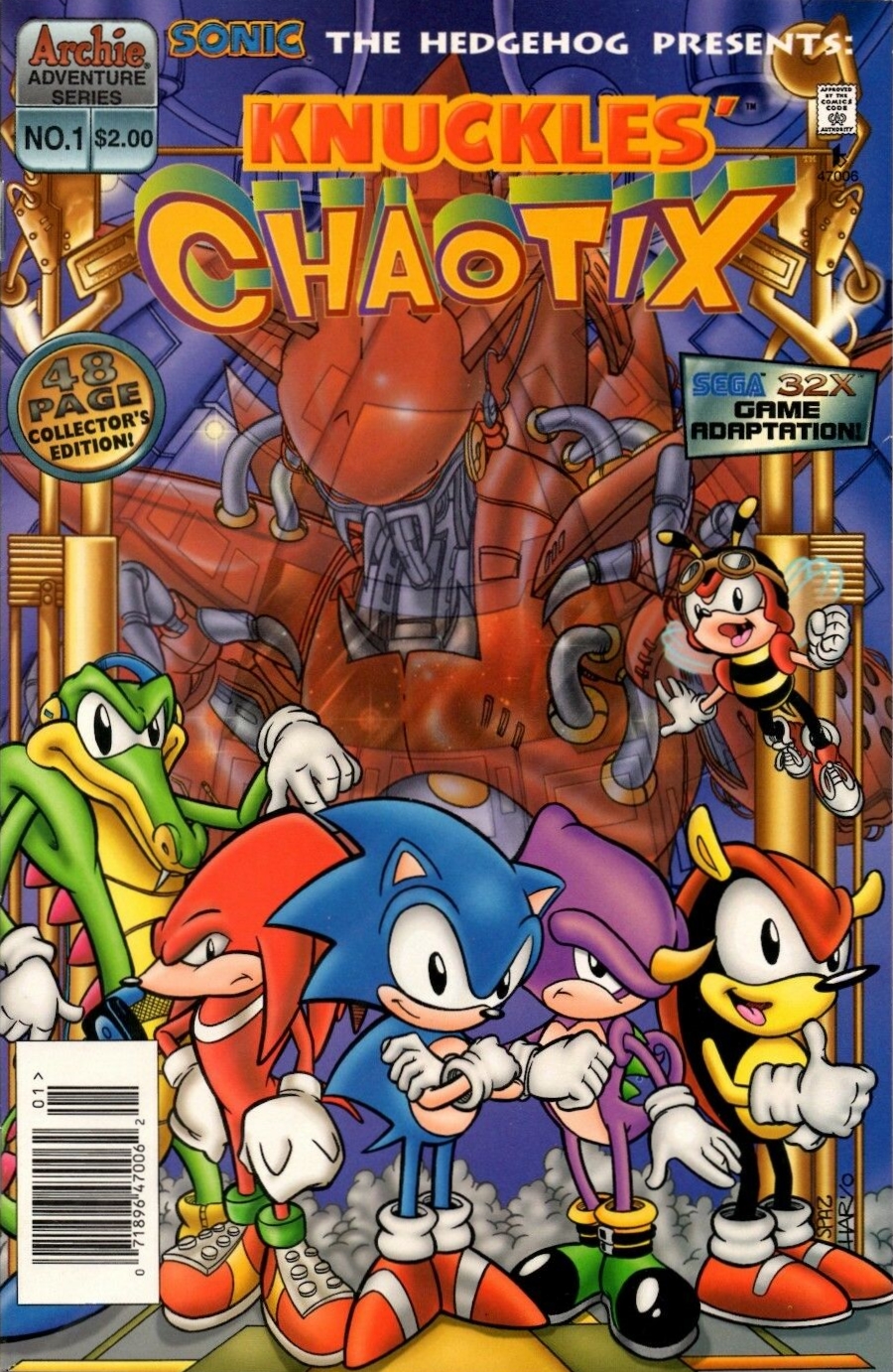
Everyone loves Knuckles the Echidna. Even if this statement isn’t true today, it was definitely the case back in the 90’s. From the moment Knuckles appeared onscreen punching out Sonic and taking the Chaos Emeralds, everyone wanted a piece of him. They wanted to know more about who he was, what secrets the floating island he lived on held, and most of all wanted to see him and Sonic tangle it up. Sonic 3 & Knuckles delivered on all counts, but that wasn’t enough to satisfy a child of the 90’s. They wanted more, and Sega, knowing the character’s growing popularity, was prepared to give them exactly what they asked for.
This isn’t the best time to get into the short, sad life of the Sega 32X, but needless to say it didn’t do well in any regard. Even though it was on the market for a short time, the powers-that-be knew that some sort of Sonic-related title needed to be released. And what started out as a proof-of-concept having Sonic and “Tails” tethered together turned into the much-forgotten Chaotix, starring Knuckles the Echidna. In the west, the title added Knuckles’ name to the cover, just to remind people that, yes, this was a game with Sonic characters, even though just about every kid in America had no idea what the origins of Charmy, Vector, and Mighty were historically.
I’m sure you can guess by now that Archie had to adapt it.

With the excitement over Sonic Generations bubbling all over the Internet, people have been looking back on the classic games, hyping themselves up over what may be coming down the pipeline. What zones might come back, what friendly classic faces they’re going to run across again, hoping beyond hope for Metal Sonic to redeem himself for what he did in Sonic Heroes. Looking back on the classic era, it might be easy to overlook the Master System/Game Gear games, since the first two weren’t as critically hailed as their Mega Drive/Genesis counterparts. But the Sonic & Tails series (known as Sonic Chaos and Sonic Triple Trouble over here in the west for…well, I have no idea why) delivered some amazing moments on its own, even with the restraints by the 8-bit hardware. Many people even think of Sonic & Tails 2 as a contender for the “true” Sonic 4, since it was made during the same era. And it does have Fang the Sniper. Who doesn’t love Fang the Sniper?
So of course, Archie had to make it a comic book.
I’m not entirely sure if Sega asked Archie to make this or not, since it was a Game Gear title and, while a money maker for Sega, not nearly as high profile as their major titles. With a cover date of October 1995 (meaning it came out a couple months before…but still way after the fact when you take the game’s release date into consideration) the cover proudly states its collector’s edition status. The four-part, 24 page tale hiding within, written by Mike Gallagher and drawn by Dave Manak, is sure to be a rip-roaring good time, so without further adieu, let’s jump inside!

People love anniversary issues in the comic book world. Every 25 issues, something intense has to happen. Something crazy. And with the 50 and 100 marks, it has to be even bigger and crazier. Sonic the Hedgehog is no exception to this rule, and his first anniversary issue wanted to be nothing but the biggest and best. Devoting an entire issue to one story, the crew at Archie comics decided to adapt Sonic’s other “best game ever,” the one and only Sonic the Hedgehog CD. And even though it features the Knothole Freedom Fighters, I can say right now that it stays far more faithful than Sonic’s last two outings in the world of game adaptations. With that said, was it any good? Did people care? How was Sonic‘s silver anniversary when all was said and done? Read on and find out, good sirs and madams!
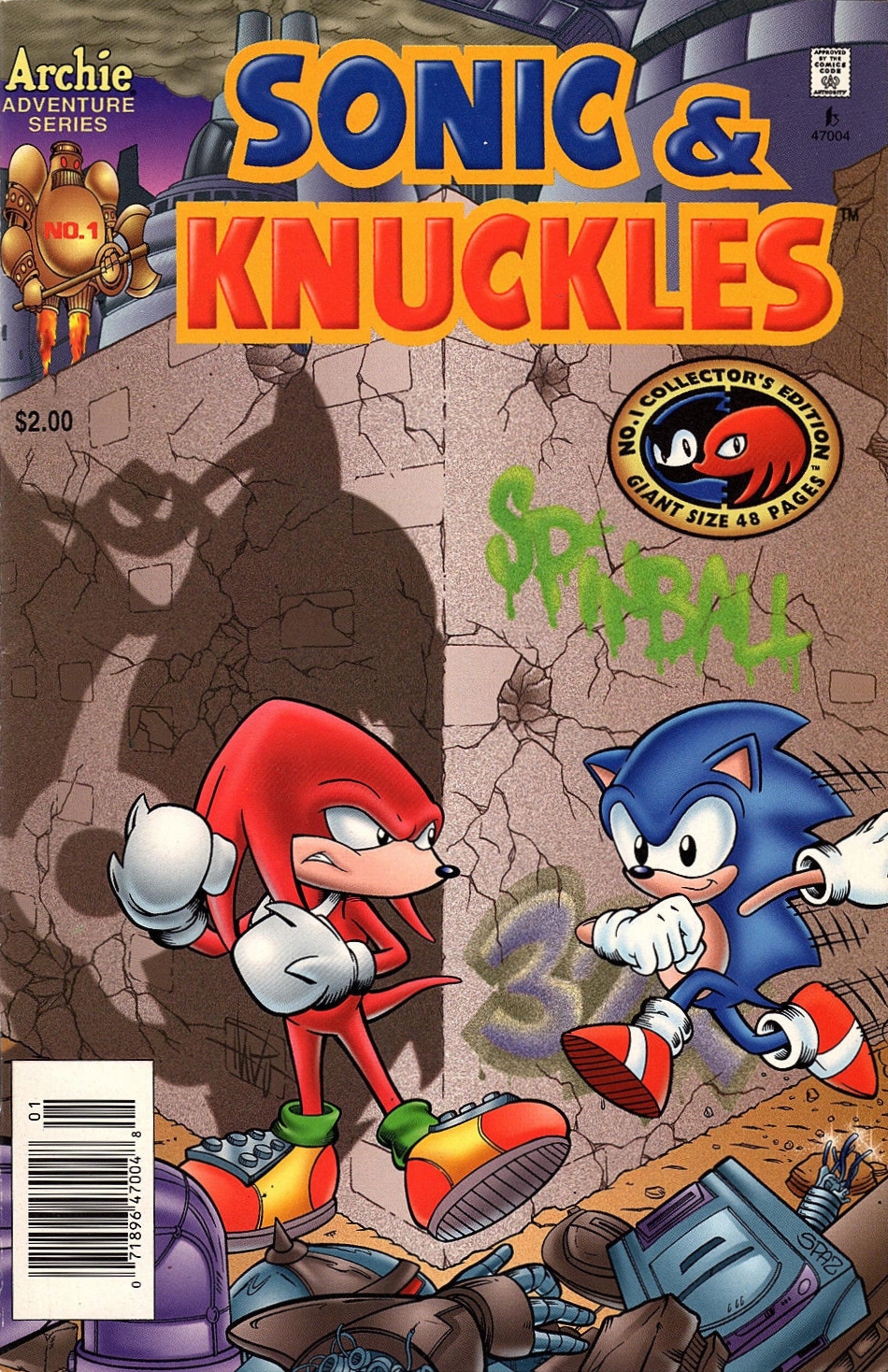 Issue 225 gets closer with every passing moment. Even though you can argue about the quality of the comic (and believe me, I’ve heard it all) you still can not deny that the fact the series has gone on this long is an amazing accomplishment. Every other series of its kind has quietly gone under, disappearing once their show/game/movie was out and done with. The Sonic series, even through the dark times, has been holding on, not only being the longest and most successful video game comic, but still one of Archie’s top sellers. The only good thing about making a comic based on a successful video game series is that there is no shortage of material, with at least one new game coming out each year. And hey, with twelve issues needing to be filled per year, who knows how much you can derive from one game? Two issues? Four? Seven?!
Issue 225 gets closer with every passing moment. Even though you can argue about the quality of the comic (and believe me, I’ve heard it all) you still can not deny that the fact the series has gone on this long is an amazing accomplishment. Every other series of its kind has quietly gone under, disappearing once their show/game/movie was out and done with. The Sonic series, even through the dark times, has been holding on, not only being the longest and most successful video game comic, but still one of Archie’s top sellers. The only good thing about making a comic based on a successful video game series is that there is no shortage of material, with at least one new game coming out each year. And hey, with twelve issues needing to be filled per year, who knows how much you can derive from one game? Two issues? Four? Seven?!

Sonic the Hedgehog has always been about the games. Say what you will about the comics, or the TV shows, or novels that feature tractors, but at the end of the day, Sonic the Hedgehog is a gaming franchise. While everything else can keep the icon in the public’s mind, SEGA has always been more concerned about how many units they can move than the plot of Sonic Underground. After all, that’s where they make their money. That’s where the state of the franchise is derived. That is what so many blogs and news sites focus on when they think “Sonic the Hedgehog.”
With Sonic’s 20th anniversary, there is going to be plenty of reflection on the franchise. I predict no less than fifty blog sites will put up “the top ten best Sonic games ever” that will feature the genesis games, Sonic CD, and Sonic Adventure in the top spots, with maybe the random “Sonic Advance” or “Sonic Triple Trouble” to break up the monotony. I know that, at least for me, I’m not going to sully the front page of this fine establishment with such a list. That is why I turn my attention for the moment on something that I am far too familiar with…the Archie Sonic the Hedgehog series.
An important update from SEGA regarding Sonic comics: pic.twitter.com/qy9BKkmIvA
— Sonic the Hedgehog (@sonic_hedgehog) July 19, 2017
After 24 long years with plenty of ups and downs, the Sonic the Hedgehog Twitter confirmed today that the Archie Sonic series has finally been put to rest. This comes after months of silence from both parties as the series was put on hiatus after 290 at the end of 2016. The comic has run alongside Sonic since 1992 and featured characters from both the video games and the Saturday Morning Cartoon.
For those wanting to reminisce on Archie’s take of the games, check out “How Archie Played the Games” and “Mobius: 25 Years Later,” by our very own David the Lurker.
